Strategic Configurations in Office Furniture Layouts


Intro
In today’s rapidly evolving workplace, the arrangement of office furniture plays a pivotal role in shaping not only the aesthetics of the space but also the dynamics of collaboration and productivity. A thoughtfully crafted environment can often be the catalyst that drives innovation and enhances employee well-being. This exploration delves deep into strategic configurations of office furniture, spotlighting how different layouts can create a harmonious balance between form and function.
To truly appreciate the impact of furniture arrangement, one must consider various facets. From the layout’s direct influence on workflow to the subtle cues that affect mood and motivation, the design choices made in any work environment are laden with significance.
Design Inspirations
When it comes to office furniture configurations, inspiration can stem from an array of sources. The challenge often lies in translating this inspiration into a space that promotes both efficiency and comfort.
Trending Styles
Office design trends have shifted towards creating environments that echo adaptability and creativity. Here are a few noteworthy styles:
- Open Concept: This style encourages collaboration by eliminating barriers, creating a space where brainstorming sessions can happen spontaneously.
- Activity-Based Working (ABW): ABW promotes flexibility, allowing employees to select workspaces that suit their tasks for the day—think cozy nooks or lively communal tables.
- Biophilic Design: Integrating natural elements—plants, natural light, and organic materials—into the workspace boosts morale and promotes well-being.
Each style comes with its unique furniture configuration, inviting users to immerse themselves in their chosen environments.
Color Palettes
Color isn’t just a visual element; it emotionally resonates with those in the space. Selecting an apt color palette can profoundly influence employee engagement and productivity. Here are some considerations:
- Blue: Often associated with calmness, blue can boost concentration—a great choice for areas dedicated to deep work.
- Green: This color fosters balance and productivity. Incorporating green tones can create a refreshing work environment.
- Yellow: Associated with energy and optimism, yellow may enhance creativity but should be used in moderation.
In essence, the choice of colors can complement the functionality of the furniture arrangements, nourishing the work atmosphere.
"A well-designed workspace is not just about aesthetics; it’s about fostering an environment that cultivates motivation and collaboration."
Maintenance and Upkeep
Design is only half of the equation—maintenance ensures that the workspace continues to reflect a well-thought-out plan year-round.
Seasonal Maintenance Checklist
To keep office furniture looking its best, a seasonal maintenance checklist can be a lifesaver. Some key items include:
- Inspecting for wear and tear and addressing issues promptly.
- Deep cleaning upholstery and surfaces, ensuring a healthy workspace.
- Rotating furniture periodically to prevent uneven wear.
Cleaning and Organization Tips
A clutter-free environment is essential for fostering productivity. Here are some practical tips:
- Use organizers and storage solutions effectively to keep surfaces clear.
- Schedule regular cleaning to maintain a tidy atmosphere.
- Encourage employees to have designated personal spaces to enhance ownership of their work areas.
In summary, a strategic approach to office furniture configurations blends design, maintenance, and overall culture into a cohesive entity. Understanding how these factors intertwine equips businesses and individuals to create workspaces that not only look sophisticated but also serve a higher purpose.
Preface to Office Furniture Configuration
A well-thought-out office layout goes beyond mere aesthetics; it serves as the backbone of a functional workspace. This section will dig into the essential considerations surrounding office furniture configurations, shedding light on how such arrangements can significantly impact productivity, employee satisfaction, and even company culture. In today’s competitive business landscape, understanding how to strategically configure office furniture is not just an option, but a necessity. It delivers tangible benefits, including maximizing space utilization, fostering collaboration, and ensuring comfort.
Understanding Office Space Dynamics
Office spaces are alive with energy and interaction, much like a bustling marketplace. The arrangement of furniture plays a critical role in this dynamic, acting as an invisible hand that guides movement, conversation, and workflow. How one structures their office layout can either lead to a harmonious environment or create barriers to communication and productivity.
For instance, consider an office where the desks are positioned back-to-back. This not only limits visibility but may also stifle open discussion among team members. Conversely, an arrangement that promotes openness—such as circular or U-shaped arrangements—can enhance interaction and promote a vibrant office culture. It's akin to arranging a dance floor; the layout influences the flow of movement and the nature of the interactions that occur.
The Importance of Furniture Layout
The furniture layout is more than just a placeholder for tech and stacks of paperwork; it's a direct reflection of an organization's values and mission. Thoughtful furniture configuration can nurture collaboration while encouraging individual focus. A common pitfall many organizations fall into is neglecting the relationship between furniture layout and employee morale. An inefficient design can lead to distractions, reduced productivity, and increased frustration.
"The right furniture placement can transform a chaotic office into a productive haven."
When it comes to space management, less is not always more. Spaces should be intentionally designed to cater to various functions—meetings, collaborative sessions, quiet work, and breaks. Ensuring that the layout supports these needs can result in a well-balanced work environment.
Types of Office Layouts
In an ever-evolving work environment, understanding the different types of office layouts holds paramount importance. The design of a workspace shapes not only the aesthetic appeal but also the functionality, influencing employee productivity and morale. A well-thought-out layout addresses specific needs, fostering collaboration where it’s vital or providing privacy when it’s necessary. Effective office layouts can significantly enhance workflow and contribute to a more harmonious workplace culture.
Open Office Spaces
Open office spaces have gained traction over the recent years, becoming synonymous with modern workplace environments. This layout usually involves minimal barriers between workers, promoting communication and collaboration. In these spaces, you often find large communal desks or workstations filled with employees engaging in discussions, brainstorming sessions, or simply exchanging ideas.
However, it’s not all sunshine and rainbows—while open offices encourage teamwork, they can also lead to distractions. Background noise or frequent interruptions might disrupt concentration, making it crucial for companies to strategically incorporate quiet zones or sound-absorbing materials to address this challenge. Moreover, technology plays a vital role in enhancing open office layouts, allowing for the integration of noise-canceling devices or flexible partitioning systems.
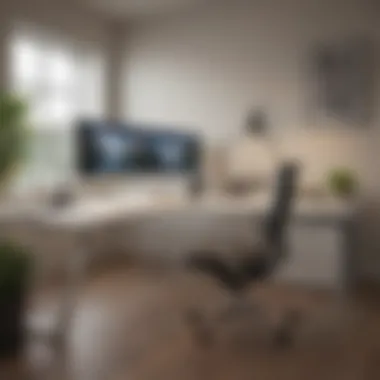
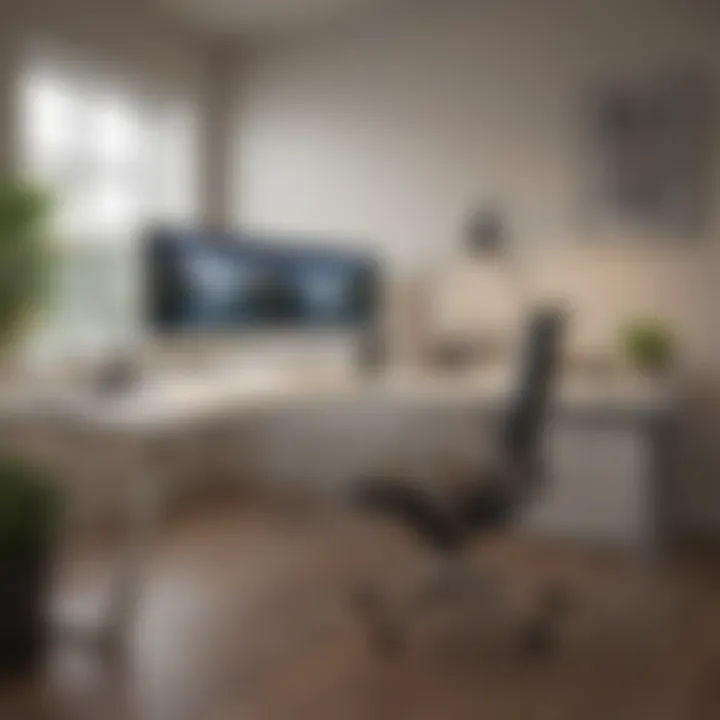
Private Offices
On the opposite end of the spectrum, private offices provide a sanctuary for focused work. These spaces are designed for individuals or small teams, emphasizing privacy and concentration. Commonly sought after in traditional corporate settings, private offices offer a haven away from the hustle and bustle of bustling office life. They often feature substantial desks, ergonomic chairs, and personal decor to create an inviting atmosphere that reflects an employee's personal style.
The major advantage of private offices lies in the reduced distractions, enabling employees to delve deep into tasks without external interruptions. However, they can inadvertently foster isolation and limit spontaneous collaboration. Therefore, many workplaces are leaning toward designs that combine private offices with shared spaces, allowing for the best of both worlds—a balance between focused work and team engagement.
Collaborative Areas
Collaborative areas are becoming increasingly essential in today's fast-paced work culture. These zones are intentionally crafted for teamwork, dialogue, and idea-sharing, featuring comfortable seating arrangements, vibrant colors, and creative decor to inspire innovation. Whether it’s a sofa, a series of movable chairs, or a more casual café-style environment, these areas are designed to break down barriers, allowing employees to connect freely.
Investing in such spaces can yield significant benefits. When employees feel encouraged to share ideas and work together, they often produce better outcomes and a stronger sense of belonging. It’s essential, however, for these areas to be strategically placed within the overall office layout to ensure accessibility without obstructing workflow in other parts of the office.
"A thoughtfully designed workspace can be the difference between a day spent in productive focus and one lost to distraction."
In summary, choosing the right office layout isn’t merely an aesthetic consideration—it is a strategic decision that can influence employee productivity, creativity, and overall job satisfaction. Recognizing how to blend open spaces, private offices, and collaborative areas can help organizations foster an environment that meets the diverse needs of their workforce.
Ergonomics in Office Furniture
Ergonomics plays a pivotal role in contemporary office furniture design, transcending mere aesthetics to influence employee well-being and productivity. At its core, ergonomic design revolves around understanding how people interact with their work environment. It seeks to optimize comfort, reduce the risk of injury, and enhance overall efficiency in the workplace. Given the significant amount of time people spend seated at desks, the need for ergonomic solutions has never been more pertinent.
Importance of Ergonomic Design
Emphasizing ergonomic design in the workplace is not just a trend; it’s fundamentally a matter of health and effectiveness. A well-structured ergonomic environment fosters better posture, reducing strain on the back, neck, and shoulders. This is particularly crucial in jobs that require long hours of seated work. When employees are comfortable, they are likely to experience higher levels of job satisfaction and lower absenteeism due to physical discomfort.
Moreover, incorporating ergonomics can lead to greater productivity. When workers feel physically stable and pain-free, they can concentrate more on their tasks rather than being distracted by discomfort. Consequently, ergonomic design leads to a more engaged workforce that performs at higher levels than their counterparts in poorly designed spaces.
Key Features of Ergonomic Furniture
To maximize the benefits of ergonomic furniture, certain key features should be considered. Here are three significant categories that play a role in boosting workplace comfort:
Adjustable Desks
Adjustable desks have become a popular choice in modern office settings. Their primary feature is the ability to change height, allowing users to alternate between sitting and standing throughout the day. This adjustment capability promotes better blood circulation and reduces the negative effects of prolonged sitting, such as back pain and fatigue. One unique aspect of adjustable desks is their adaptability to different body types and personal preferences. This tailored fit is one reason why they are immensely beneficial.
However, while adjustable desks have numerous advantages, they also come with potential drawbacks. Some users may find it challenging to adjust to a standing position if they are accustomed to sitting for long hours. Furthermore, the investment in high-quality models can be substantial, which may deter some organizations from fully integrating this solution into their office layout.
Ergonomic Chairs
Ergonomic chairs are designed with advanced features that support the natural alignment of the spine. A key characteristic includes adjustable lumbar support, which fits the lower back's curvature and helps maintain posture. By providing adequate support, these chairs can significantly lower the risk of developing chronic back problems. As a result, ergonomic chairs are a crucial aspect of creating a healthy workspace.
Nevertheless, it’s important to consider that not all ergonomic chairs are created equal. Some may lack sufficient adjustability or cushioning, which can lead to discomfort over prolonged use. Therefore, investing time in selecting the right chair becomes vital to ensure it meets the specific needs of the user.
Workstation Accessories
Workstation accessories like keyboard trays, monitor stands, and footrests complement ergonomic desks and chairs by enhancing the overall setup. These accessories are crafted to encourage a healthy posture while using technology. For instance, monitor stands help position screens at eye level, preventing neck strain. Such items are beneficial additions to any workspace, ensuring customers optimize their ergonomic environment.
However, there��’s a caveat. Not every accessory fits every workspace or user preference. Some products can be cumbersome or tricky to install, making it essential for organizations to evaluate which accessories truly enhance their setup and match their employees' work habits.
"An ergonomically sound workspace not only improves comfort but also positions employees to deliver their best performance."
Aesthetic Considerations in Office Furniture
In the landscape of office design, aesthetics are more than just eye candy. They are critical in establishing a work environment that not only fosters productivity but also encourages a sense of belonging and inspiration among employees. The right aesthetic choices can set the tone for the organization and communicate its values. When contemplating office furniture, consideration of aesthetics spans color schemes, material choices, and overall design language. Together, these elements create an atmosphere that can either invigorate or stifle creativity and motivation.
A pleasing visual environment contributes significantly to employee morale and satisfaction, making aesthetic considerations vital in any furniture layout. When the space looks polished and deliberate, it can also make a strong first impression on clients and visitors. It's about striking a balance where beauty meets functionality, ensuring no element overshadows the other.
"An office interior should reflect its function, but it should also uplift the spirit of those who dwell within."
Color Psychology in the Workplace
The color of office furniture can play a pivotal role in shaping the behavior and emotions of those who occupy the space. Each hue has its own psychological effects. For instance, blue is often associated with calm and focus, making it a popular choice for areas designated for thinking and reflection. On the flip side, warmer tones like reds and oranges might evoke a sense of energy and enthusiasm, ideal for collaborative spaces where brainstorming occurs.
When selecting colors, consider the following:
- Purpose of the Space: Different activities may benefit from distinct colors. A creative studio might thrive in vibrant shades while a conference room may prefer more subdued tones to encourage serious discussions.
- Brand Identity: Colors can convey brand values; for example, a tech startup might choose sleek silver or blue to evoke innovation and modernity.
- Contrast and Harmony: Utilizing contrasting colors can enhance visual interest. However, too much contrast can be overwhelming, so balance is key.
Incorporating pops of color in furniture can uplift the space. Think about a lime green chair amid a minimalist white office, or a deep burgundy desk contrasting with light wooden accents. This can create focal points that draw the eye and stir curiosity.
Material Choices for Office Furniture
Material selection is another layer of aesthetic consideration in office furniture that speaks to both style and function. The materials used can dramatically affect the visual appeal and the tactile experience of the furniture. Here are factors to ponder when making choices:
- Durability: High-traffic areas might require more robust materials, like hardwood or metal, to withstand wear and tear. Such choices meld longevity with aesthetics by presenting a polished look over time.
- Texture: Materials add depth to a space. A wood grain may evoke warmth and comfort, while sleek metals can impart a modern edge. Combining materials can lead to unique furniture solutions that catch the eye.
- Sustainability: Eco-friendly materials are more than a trend. They are an important aspect of modern aesthetics, representing a commitment to sustainability. Bamboo or recycled materials not only look good but also tell a story of responsibility.
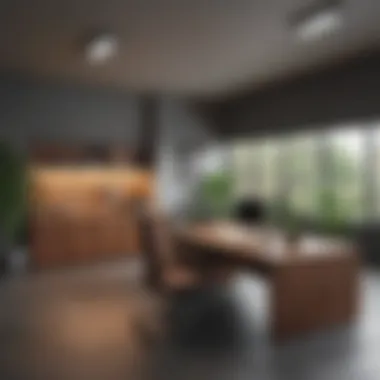
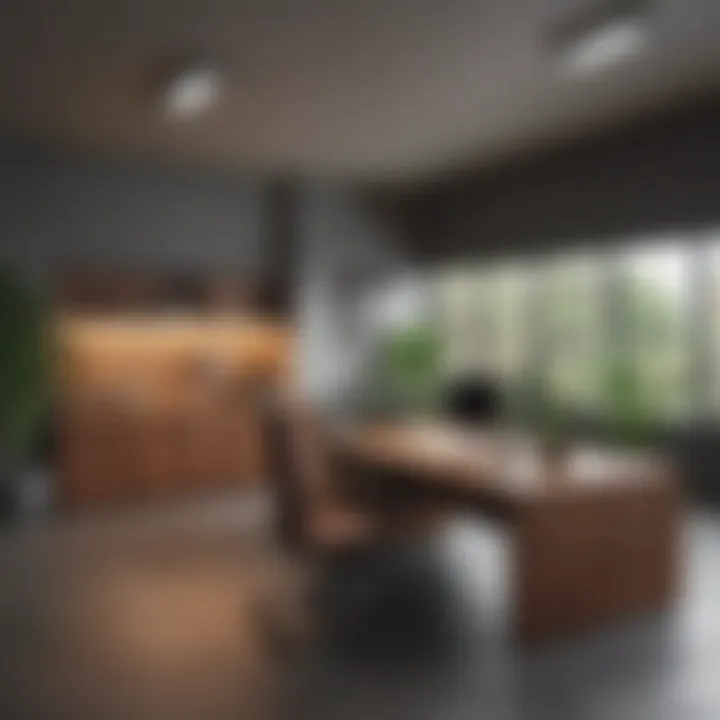
In the end, choosing materials should consider not only aesthetics but how they contribute to the culture and functionality of the office space. Elegant solutions leave an impression that enhances everyday work life, proving once more that aesthetics in office furniture are not just about looks—they are about building an environment that facilitates the productivity and well-being of its inhabitants.
Adaptability in Office Spaces
In the constantly shifting landscape of modern work environments, adaptability in office spaces surfaces as an essential focal point. As organizations juggle varying team sizes, project requirements, and diverse employee needs, a flexible approach to furniture design emerges as a game changer. With tailored solutions, firms can create optimal settings that foster productivity and collaboration, ultimately leading to a more fulfilled workforce.
Adaptability hinges on the ability to respond to unforeseen changes without compromising functionality or aesthetics. For example, a company may need to rapidly regroup its employees after a project deadline, necessitating swift rearrangements of workstations or collaborative areas. Hence, the right office configurations not only accommodate current workloads but also anticipate future demands.
Designing for Flexibility
Creating a flexible office environment is about more than just rearranging furniture; it requires an intentional design strategy that promotes movement and collaboration. In practice, this means incorporating modular pieces that can be easily reconfigured. For instance, using movable partitions can transform an open area into designated spaces for private conversations or brainstorming sessions.
Ultimately, the design should encourage employees to adapt their surroundings based on their tasks. Flexible design allows for individualized work stations where staff members can personalize their experience. It cultivates a sense of ownership while also providing quick access to shared resources, enhancing both productivity and comfort.
"Flexibility in an office is not just about furniture, it's about fostering an environment where employees feel empowered to make their space work for them."
Multi-Functional Furniture Solutions
In navigating the demands of varied work styles, the integration of multi-functional furniture provides a pragmatic yet stylish solution. Think of desks that can convert into meeting tables or storage units that double as seating—these items not only save space but also serve multiple essential purposes without cluttering the workplace. Multi-functional designs cater to the evolving nature of tasks within a workday, allowing employees to shift seamlessly between independent work and collaborative discussions.
Ideas to consider when investing in multi-functional furniture include:
- Adjustable Desks: Providing the option to sit or stand enhances comfort while working.
- Storage Solutions: Furniture with built-in storage keeps desks organized, enabling a tidy work area.
- Collaborative Units: Items designed to promote teamwork can foster creativity and problem-solving among employees.
By emphasizing adaptability and multi-functionality in office designs, businesses can cultivate workspace environments that are efficient, inviting, and responsive to both team dynamics and individual preferences.
Technology Integration in Office Furniture Design
As offices become increasingly digitized, the role of technology in furniture design has transformed from merely functional to integrative. This integration enhances not only productivity but also the overall experience within the workspace. In today's fast-paced business environment, technology is no longer a luxury; it's a necessity. Thus, understanding how to meld technology with office furniture becomes paramount. Effectively incorporating tech leads to improved communication, better organization, and ultimately, a more satisfying work environment.
Incorporating Technology into Furniture Layout
The seamless blending of technology into furniture arrangements can revolutionize how workspaces function. It's not just about slapping on a few devices; it's about crafting an ecosystem where tech feels natural, rather than tacked on. For example, consider desks equipped with built-in wireless chargers and cable management systems. Such setups eliminate clutter and promote a clean, organized look.
Think about the following elements when incorporating technology into your furniture layout:
- Power Access: Desks designed with integrated power outlets enable easy access to charging devices.
- Data Management: Innovative furniture pieces that house network connections minimize the visual chaos of cords and cables.
- Collaborative Tools: Conference tables that host built-in screens or whiteboards enhance meeting efficiency by encouraging real-time collaboration.
This thoughtful placement creates a harmonious balance between tech and traditional elements, fostering a more functional environment.
Smart Furniture and Ease of Access
The rise of smart furniture asserts itself as more than just a trend; it's a response to modern challenges. Smart desks and chairs that automatically adjust to prescribed heights unlock the potential for greater ergonomic benefits. Imagine a workspace that anticipates your needs—chairs that offer reminders to stand or desks that notify you of a new message.
Such ease of access transforms the mundane into a personalized experience. For optimal integration:
- Sensor Technology: Utilizing motion sensors to turn lighting on and off based on occupancy.
- IoT Integration: Leveraging the Internet of Things (IoT) for furniture that connects to personal devices allows for seamless transitions from work modes to relaxation.
- User Interface: Implementing user-friendly interfaces helps simplify interactions with technology in furniture, catering to a wide range of tech-savvy skills.
"Incorporating technology into furniture design isn't just about making things look good; it's about creating a user experience that keeps pace with our evolving needs."
As the landscape shifts towards a hybrid work model, ensuring that technology plays a central role in furniture design signals preparedness for what lies ahead. It's essential to view this integration not merely as an enhancement but as a foundational component of a modern workspace.
Sustainability in Office Furniture Choices
As businesses recognize the significance of environmental concerns, the drive for sustainable office furniture choices has grown stronger. This section delves into how adopting sustainable practices not only benefits the planet but also enhances an office's aesthetic and functional appeal. The movement towards eco-friendly materials and strategies is more than a trend; it reflects a fundamental shift in how we perceive space. Choosing sustainable materials can instill a sense of well-being in employees, fostering an environment that aligns with modern values.
Understanding sustainability in office furniture involves looking at the materials used, manufacturing processes, and overall life cycle of the products. It’s not just about being green; it's about creating spaces that resonate with users and the environment. Investing in eco-friendly options can yield significant benefits, from increased employee satisfaction to a stronger public image.
"In the quest for a more responsible office, sustainability must become a cornerstone."
Eco-Friendly Materials and Practices
When discussing eco-friendly materials, one cannot overlook the variety of choices that range from recycled metals to sustainably sourced wood. For example, chairs made from recycled plastics or desktops from reclaimed wood illustrate a commitment to sustainability. These materials often have a smaller carbon footprint than traditional ones.
Key elements to consider when selecting eco-friendly products include:
- Natural fibers: Hemp, cotton, and wool offer durability and comfort.
- Bamboo: A rapidly renewable resource, bamboo is versatile and strong.
- Recycled materials: Furniture crafted from recycled plastics reduces waste.
Employing sustainable practices in production is equally crucial. Manufacturer certifications, like those from the Forest Stewardship Council, indicate that a product is sourced ethically. By choosing brands that prioritize these factors, businesses contribute to a larger movement aimed at preserving our planet.
The Role of Sustainability in Office Design
Sustainability plays a pivotal role in shaping the future of office design. It goes beyond furniture choices; it's about creating a holistic environment that encourages productivity while maintaining ecological integrity. Designing sustainable office spaces can influence how employees perceive their workplace, leading to a more engaged workforce.

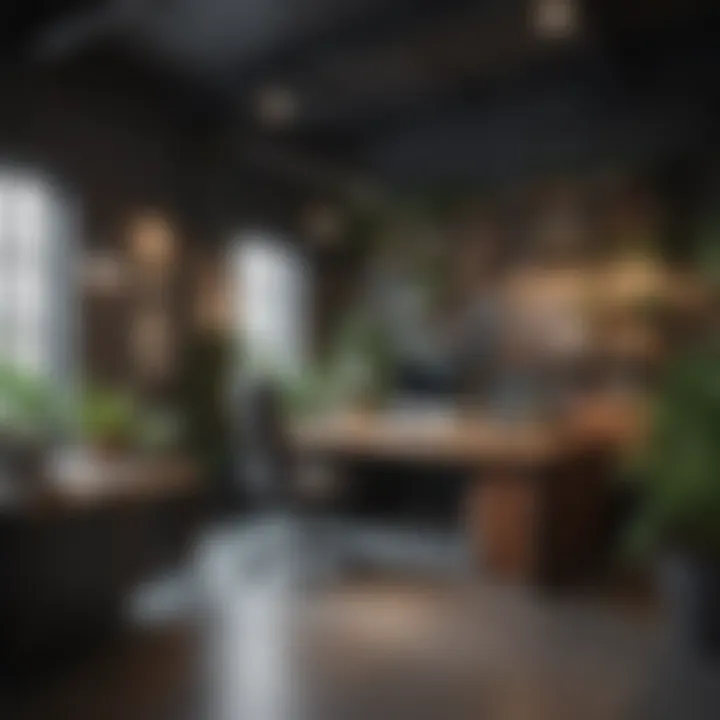
Considerations for sustainability in office design include:
- Energy-efficient layouts: Maximize natural lighting to reduce energy consumption.
- Indoor plants: Not only do they improve air quality, but they also enhance mental well-being.
- Furniture longevity: Invest in durable, timeless pieces that reduce waste.
Moreover, eco-friendly design can lead to cost savings in the long run, as energy-efficient options often reduce operational costs. Companies viewed as sustainable attract consumers and talent who value ecological responsibility.
In summary, integrating sustainability into office furniture choices is a multi-faceted approach that encompasses material choices, company values, and employee satisfaction. The impact of these thoughtful decisions reverberates through an organization, fostering a culture that respects both people and the planet.
Case Studies on Successful Office Furniture Configurations
Examining actual scenarios provides invaluable insights into the advantages of strategic office furniture configurations. Case studies allow us to look beyond theory and visualize how thoughtful design and layout can enhance workplace dynamics. These real-world examples help in understanding the best practices and guiding principles that lead to increase productivity and employee satisfaction. Here are some key aspects to consider:
- Real-Life Application: By seeing how different companies adapt furniture configurations, one can grasp what works practically.
- Tailored Solutions: Every company has unique needs. A case study might reveal how a specific layout addresses those needs effectively.
- Adaptation over Time: Many companies evolve. Case studies show how furniture arrangements can be modified to keep pace with changing workplace environments.
“Design is not just what it looks like and feels like. Design is how it works.”
– Steve Jobs
Innovative Corporate Environments
Innovative corporate environments are prime examples of how strategic office furniture configurations can stimulate creativity and engagement amongst employees. Take a look at tech giants like Google and Facebook. They have mastered the art of creating dynamic workspaces that blend aesthetics with functionality. In these offices, there’s an emphasis on open spaces that encourage collaboration while also incorporating areas for quiet concentration.
In many cases, these environments are filled with modular furniture. This design flexibility allows teams to shift their space according to project needs. For instance:
- Flexible Seating Arrangements: Teams can easily arrange seating in a circular pattern during brainstorming sessions or convert them into small clusters for focused discussions.
- Breakout Zones: Casual seating areas furnished with bean bags or low sofas inspire relaxation and informal interactions, fostering spontaneous conversations.
- Purposeful Decor: Diverse textures and colors can be found throughout these spaces. Think about a vibrant mural next to a sleek wood desk. It creates an inviting ambiance that reflects a company's culture.
Through thoughtful furniture choices, these corporate settings not only inspire their employees but also attract talent, reinforcing their status as industry leaders.
Flexible Workspaces in Startups
Startups typically operate with diverse strategies, and flexibility in office configurations is crucial for their rapid growth and innovation. Unlike larger enterprises that may have fixed layouts, startups often require adaptable solutions that accommodate changing team sizes and project phases.
For example, a well-known startup focusing on app development transformed a typical office layout into a multi-functioning space. They implemented:
- Hot Desking: Allowing employees to choose their workspace daily promotes movement and can help spark new ideas. It reduces feelings of monotony.
- Convertible Furniture: For instance, collapsible meeting tables and stackable chairs enable spaces to transition from meetings to social gatherings with ease.
- Zoning Areas: Designating zones for teamwork, solo tasks, and relaxation aids in productivity. Employees can shift their location based on their current needs, which keeps the work dynamic.
These real-life examples underline that by embracing strategic configurations in office furniture, startups can cultivate an energetic, creative, and flexible work culture.
Future Trends in Office Furniture Configuration
As the way we work adapts to the fast-paced changes in society, the configurations we choose for our office environments must also evolve. Understanding future trends in office furniture configuration is crucial for creating workplaces that meet modern needs while enhancing productivity and employee satisfaction. Companies are increasingly recognizing that furniture choices can create or break the working environment, leading to an upsurge in innovative design solutions that cater to hybrid work models, ergonomic considerations, and sustainability efforts.
The Shift Towards Hybrid Work Models
The shift towards hybrid work models signifies a fundamental change in how office spaces are utilized. With employees dividing their time between home and office, the physical layout of the workspace needs to accommodate flexibility. This blend allows for a dynamic work environment that supports varied work styles, collaboration, and social interaction.
Hybrid setups call for configurations that include adjustable desks, easily movable furniture, and communal spaces designed for both focused work and group collaboration. It's vital that furniture promotes a balance; it needs to facilitate privacy when working solo while also fostering community during team activities.
Incorporating multi-functional furniture becomes an asset - think modular seating arrangements or desks that easily rearrange. The furniture should adapt like a chameleon, changing its function based on need, whether it’s a brainstorming session or a peaceful focus hour.
"Flexible office environments empower businesses to stay ahead, effortlessly adapting to employee needs and technological advancements".
Predictions for Office Design Evolution
Looking ahead, it's clear that office design will continue to evolve as the influence of technology and employee preferences deepen. One firm prediction is an increase in the integration of smart technology into office furniture. Desks embedded with charging ports, chairs with posture recognition, and systems that monitor well-being can lead to a seamless blend of work and comfort.
As companies adapt to the digital landscape, expect a rise in AI-driven furniture solutions. These advancements can monitor usage patterns and suggest configurations, ensuring every inch of space serves its purpose efficiently.
Moreover, sustainability will play a pivotal role in office design evolution. The demand for eco-friendly materials and practices will increase, leading designers to source responsibly and create furniture that aligns with environmental goals. Expect office furniture that is not only aesthetically pleasing but also made of recycled or renewable materials, bringing a fresh air of conscientiousness into the workplace.
Ending
The conclusion serves as the final piece of this intricate puzzle concerning office furniture configuration. It encapsulates the essence of how layout and arrangement play a vital role in shaping not just the physical environment but also the emotional well-being of individuals within a workspace. By weaving together all previous sections, it highlights the significance of thoughtful design—urging decision-makers to rethink the ways they configure their offices.
Summarizing Key Points
In reflection, several critical themes emerge from our exploration of office furniture configurations:
- Impact on Productivity: The arrangement of furniture directly influences how efficiently employees can perform their tasks. An open layout might spark creativity while a more traditional setup can facilitate focused work.
- Employee Well-Being: Ergonomic considerations cannot be overlooked. Designed with health in mind, the right furniture can reduce the risk of injury and enhance comfort, creating a happier workforce.
- Aesthetic Appeal: The visual elements of office furniture contribute not only to the first impressions but also to the overall atmosphere. Colors, materials, and designs work together to foster an environment conducive to work and collaboration.
- Flexibility and Adaptability: Modern workspaces must evolve. Configurations that allow for adaptability will support changing work habits, especially with the rise of hybrid working models.
The Impact of Thoughtful Furniture Configuration
The effects of a well-planned furniture configuration extend beyond mere aesthetics. It’s about creating a culture that promotes productivity, collaboration, and well-being among employees. A strategic layout can:
- Enhance Engagement: By catering to both collaborative and individual work styles, the space invites collaboration while still allowing focus and privacy when needed.
- Stimulate Creativity: Design elements that encourage interaction and creativity can lead to innovative solutions. Spaces that break the mold can inspire ideas and foster a dynamic atmosphere.
- Facilitate Communication: Arrangements that emphasize open pathways encourage spontaneous interactions among teams, thus nurturing a more cohesive work environment.
Ultimately, the way furniture is arranged within an office space has far-reaching consequences. By taking a methodical approach to furniture configuration, businesses can significantly improve the overall work experience, ensuring that both the physical and psychological dimensions of the workplace contribute positively to productivity and satisfaction.
"The arrangement of furniture is not just about organization; it is about creating an environment where individuals can thrive and collaborate seamlessly."
This thoughtful exploration reveals that the art of configuring office furniture is an ongoing process. As strategies evolve, so too should the configurations that promote a unified and effective working environment. Embracing change in furniture layout can lead to better employee morale and improved output, making it an indispensable aspect of modern workplace design.







